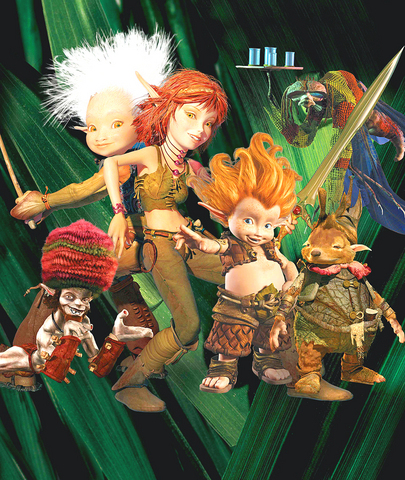In the latest wowzer merging of the real and the fabricated, Arthur and the Invisibles takes actual human actors and, through a complex process involving Slim-Fast and a Maytag dryer, shrinks them to the size of bacteria so they can interact with the microscopic beings who live in your backyard along with Rick Moranis and his family.
Or something like that. The press packet for Arthur, a children's film directed by Luc Besson, includes lots of tidbits on the magic that enabled the merging of live actors and a computer-generated world, but who can really keep track of this technogoo anymore, or get excited about it? The real question isn't how these hybrid movies are made, but why. In this case, it's a tad unclear.
The film begins in the conventional human world of the early 1960s, where Arthur (Freddie Highmore) and his grandmother (Mia Farrow) have troubles galore: Grandpa went missing a few years ago, and developers are on the verge of taking over the family homestead. Arthur manages to shrink himself to near-invisibility so he can enter a secret world and search for some gems that will solve all the problems.

PHOTOS COURTESY OF CMC
At this point the film becomes computer-generated, and also resembles, at various times, Honey, I Shrunk the Kids, The Sword in the Stone, Fraggle Rock and assorted others. The computer-generated world is visually rich, but short on the droll humor that makes good children's films bearable for adults. It's also too frenetically paced and confusing for adults or children. But many of the voices are familiar: Madonna, Jimmy Fallon, Snoop Dogg, David Bowie, Harvey Keitel, Robert De Niro and other famous names provide them. There are so many famous names that the question arises: Would this movie have been more enjoyable with the real humans instead of just their voices? Yes. Although that would have required Madonna to have a budding romance with a 'tweenage boy. Hmm.

The canonical shot of an East Asian city is a night skyline studded with towering apartment and office buildings, bright with neon and plastic signage, a landscape of energy and modernity. Another classic image is the same city seen from above, in which identical apartment towers march across the city, spilling out over nearby geography, like stylized soldiers colonizing new territory in a board game. Densely populated dynamic conurbations of money, technological innovation and convenience, it is hard to see the cities of East Asia as what they truly are: necropolises. Why is this? The East Asian development model, with

June 16 to June 22 The following flyer appeared on the streets of Hsinchu on June 12, 1895: “Taipei has already fallen to the Japanese barbarians, who have brought great misery to our land and people. We heard that the Japanese occupiers will tax our gardens, our houses, our bodies, and even our chickens, dogs, cows and pigs. They wear their hair wild, carve their teeth, tattoo their foreheads, wear strange clothes and speak a strange language. How can we be ruled by such people?” Posted by civilian militia leader Wu Tang-hsing (吳湯興), it was a call to arms to retake

This is a deeply unsettling period in Taiwan. Uncertainties are everywhere while everyone waits for a small army of other shoes to drop on nearly every front. During challenging times, interesting political changes can happen, yet all three major political parties are beset with scandals, strife and self-inflicted wounds. As the ruling party, the Democratic Progressive Party (DPP) is held accountable for not only the challenges to the party, but also the nation. Taiwan is geopolitically and economically under threat. Domestically, the administration is under siege by the opposition-controlled legislature and growing discontent with what opponents characterize as arrogant, autocratic

When Lisa, 20, laces into her ultra-high heels for her shift at a strip club in Ukraine’s Kharkiv, she knows that aside from dancing, she will have to comfort traumatized soldiers. Since Russia’s 2022 invasion, exhausted troops are the main clientele of the Flash Dancers club in the center of the northeastern city, just 20 kilometers from Russian forces. For some customers, it provides an “escape” from the war, said Valerya Zavatska — a 25-year-old law graduate who runs the club with her mother, an ex-dancer. But many are not there just for the show. They “want to talk about what hurts,” she